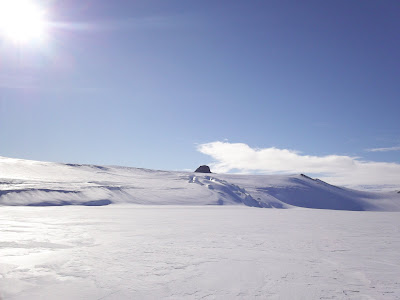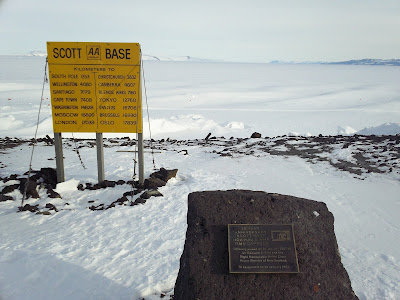Monday, October 31, 2011
Hiking up Castle Rock, then snowboarding down
It was a nice sunday so we hiked up to Castle Rock and snowboarded down. It was about an 8 mile loops. We snowboarded about a 2 mile descent and hitch hiked the last stretch after a truck came by on the way back from the Long Duration Ballon Facility.
Friday, October 28, 2011
Living Module in one of the Traverse Trailers
Eight guys will be living in there for about 50 days on the rountrip overland traverse to the South Pole. But good news is they now have internet!
Weather Satellite uplink
A weather satellie launched out of Vandenberg yesterday on a Polar orbit and here is uplink only ground station that it'll be talking to. Thanks to this guy we got links upgraded.
More Info on the system:
Unlike the other systems we have for weather this one isn't just for Antarctica.
Thursday, October 27, 2011
Whats in the bin?
Condoms and babies. There's a bin called "Glitter" and one called "Urine Soaked Pants". Think I'll search for USP the day after holloween.
Tuesday, October 25, 2011
Amber Waves Band
A plug for my coworker's brother's band/family.
http://amberwavesband.com/
They have sold their house, bought an old school bus and converted it into a tour bus and are touring across the country playing bluegrass/gospel music. They've gone all in, so hope you all like them.
http://amberwavesband.com/
They have sold their house, bought an old school bus and converted it into a tour bus and are touring across the country playing bluegrass/gospel music. They've gone all in, so hope you all like them.
Vince's Cross
Vince's Cross on Hut Point. This was erected on the first Scott Expedition in 1902 as a memorial for George Vince, who died in McMurdo Sound on that expedition. Crazy windy out there today, I could barely standup to take this picture.
Scott's Hut
This is the hut build by Robert "Best Middle Name Ever" Scott's second expedition. Five men reached the pole by foot from the this starting point on the coast in 1911-12. All five, lead by Scott died on the way back. It took a week before I realized I was staring at this hut everyday from my office window in the JSOC. It didn't look like it was build exactly 100 years ago. In front as well as on the seaside are plaques comemorating the men who sailed on the Discovery, Scott's ship.
Saturday, October 22, 2011
This One is Our Sign
Right across from the Kiwi's sign. You can see the windmills and the beach ball in the background. The beach ball has an old NASA antenna and the CTBT relays.
Sign on the Road
Although Antarctica is non soveirgn territory, apparently the Kiwis have laid a claim. I like the icon of a tree and a bench. There is not one tree on this continent that isn't plastic. Parrots and cats for that matter either.
Mt. Erebus
The volcano which is responsible for this little island we sit on. Smoke plumes coming out of it. Comforting to know that just behind our base is this monster.
Thursday, October 20, 2011
Wednesday, October 19, 2011
The Traverse
A tractor made by Case. The real adventure in Antarctica is in the traverses. Many countries have coastal stations along the ice shelf, but there there are many others along the interior on the Plateau. We have the South Pole Station, then is also Vostok, a Japanese station and some others. We resupply the South Pole with Basler and ski equipped LC-130 aircraft. Recently we have also been using overland traverse vehicles to resupply them. The other stations like Vostok do an overland traverse as well since their air assets are not as extensive as ours.
This year there will be two traverses to resupply South Pole Station comprised of haulers like these manned by 10-12 men dragging hundred of thousands of gallons of fuel in fuel bladders as well as pallets and living pods. Last year it took one of the teams 82 days to read the South Pole. They got caught in a storm. Along the way they will drive over sea ice, survey crevasses to make them passable and climb the nearly 10,000 feet to South Pole's elevation. They will be mostly cut off except for Iridium phones and very limit internet. Along the way they will get to see and set foot on parts of this world that only a handful of men have done. One of them said that if there were pine trees here he would cut them down and build a cabin and stay.
The traverse is quite a technical feat as well. One of the vehicles carries radar mapping equipment to map out the crevasses and they have an engineering team that have optimized the operation by disposing of sleds in favor of dragging the bladders to reduce friction. They also switched to black bladders as they absorb more solar energy which translates to more heat to overcome the ice stiction. There is also a group from Carnegie Mellon that is working on automating the tractors. That way the traverse can have one operator with trailing tractors following the lead tractor. The train can then operate around the clock by having the operators work in shifts.
The most important thing the traverses haul up is fuel and compared to LC-130 flights they claim to deliver 1 gallon of fuel for every .6 gallon of fuel burned. In comparison, bringing fuel to the South Pole by air burns 1.2 gallons for every gallon delivered. So its pretty neat considering they are pushing the limits of human mental, physical endurance and are pushing technical envelopes.
This year there will be two traverses to resupply South Pole Station comprised of haulers like these manned by 10-12 men dragging hundred of thousands of gallons of fuel in fuel bladders as well as pallets and living pods. Last year it took one of the teams 82 days to read the South Pole. They got caught in a storm. Along the way they will drive over sea ice, survey crevasses to make them passable and climb the nearly 10,000 feet to South Pole's elevation. They will be mostly cut off except for Iridium phones and very limit internet. Along the way they will get to see and set foot on parts of this world that only a handful of men have done. One of them said that if there were pine trees here he would cut them down and build a cabin and stay.
The traverse is quite a technical feat as well. One of the vehicles carries radar mapping equipment to map out the crevasses and they have an engineering team that have optimized the operation by disposing of sleds in favor of dragging the bladders to reduce friction. They also switched to black bladders as they absorb more solar energy which translates to more heat to overcome the ice stiction. There is also a group from Carnegie Mellon that is working on automating the tractors. That way the traverse can have one operator with trailing tractors following the lead tractor. The train can then operate around the clock by having the operators work in shifts.
The most important thing the traverses haul up is fuel and compared to LC-130 flights they claim to deliver 1 gallon of fuel for every .6 gallon of fuel burned. In comparison, bringing fuel to the South Pole by air burns 1.2 gallons for every gallon delivered. So its pretty neat considering they are pushing the limits of human mental, physical endurance and are pushing technical envelopes.
Subscribe to:
Comments (Atom)



























